Geological Controls on Mineralogy and Geochemistry of an Early Permian Coal from the Songshao Mine, Yunnan Province, Southwestern China
Abstract
:1. Introduction
2. Geological Setting
3. Samples and Analytical Procedures
4. Results
4.1. Ultimate and Proximate Analyses and Coal Rank
4.2. Geochemical Composition
4.2.1. Major Element Oxides
4.2.2. Trace Elements
4.2.3. Rare Earth Elements
4.3. Mineralogical Composition
4.3.1. Mineral Phases
4.3.2. Comparison between Mineralogical and Chemical Compositions
4.3.3. Modes of Mineral Occurrence
Clay Minerals
Boehmite, Disapore, Brucite
Pyrite and Marcasite
Calcite
Antase and Zircon
Apatite, Halotrichite, and Stannite
REE-Bearing Minerals
5. Factors Controlling Enrichment of Trace Elements and Minerals in Songshao Coal
5.1. Input from Sediment-Source Region
5.2. Hydrothermal Fluid Influences
5.3. Marine Environments
6. Conclusions
Acknowledgments
Conflicts of Interest
References
- Yunnan Coal Geology Prospecting Team No. 143. Report on Coal Geological Exploration of Songshao Mine; Yunnan Coal Geology Prospecting Team No. 143: Qujing, China, 1996. [Google Scholar]
- Dai, S.; Wang, X.; Zhou, Y.; Hower, J.C.; Li, D.; Chen, W.; Zhu, X.; Zou, J. Chemical and mineralogical compositions of silicic, mafic, and alkali tonsteins in the late Permian coals from the Songzao Coalfield, Chongqing, Southwest China. Chem. Geol. 2011, 282, 29–44. [Google Scholar] [CrossRef]
- Ren, D.; Zhao, F.; Dai, S.; Zhang, J.; Luo, K. Geochemistry of Trace Elements in Coal; Science Press: Beijing, China, 2006; pp. 40–59. (In Chinese) [Google Scholar]
- Ward, C.R. Analysis and significance of mineral matter in coal seams. Int. J. Coal Geol. 2002, 50, 135–168. [Google Scholar] [CrossRef]
- Wang, X.; Dai, S.; Ren, D.; Yang, J. Mineralogy and geochemistry of Al-hydroxide/oxyhydroxide mineral-bearing coals of Late Paleozoic age from the Weibei coalfield, southeastern Ordos Basin, North China. Appl. Geochem. 2011, 26, 1086–1096. [Google Scholar] [CrossRef]
- Dai, S.; Wang, X.; Seredin, V.V.; Hower, J.C.; Ward, C.R.; O’Keefe, J.M.K.; Huang, W.; Li, T.; Li, X.; Liu, H.; et al. Petrology, mineralogy, and geochemistry of the Ge-rich coal from the Wulantuga Ge ore deposit, Inner Mongolia, China: New data and genetic implications. Int. J. Coal Geol. 2012, 90, 72–99. [Google Scholar] [CrossRef]
- Dai, S.; Jiang, Y.; Ward, C.R.; Gu, L.; Seredin, V.V.; Liu, H.; Zhou, D.; Wang, X.; Sun, Y.; Zou, J.; et al. Mineralogical and geochemical compositions of the coal in the Guanbanwusu Mine, Inner Mongolia, China: further evidence for the existence of an Al (Ga and REE) ore deposit in the Jungar Coalfield. Int. J. Coal Geol. 2012, 98, 10–40. [Google Scholar] [CrossRef]
- Dai, S.; Seredin, V.V.; Ward, C.R.; Jiang, J.; Hower, J.C.; Song, X.; Jiang, Y.; Wang, X.; Gornostaeva, T.; Li, X.; et al. Composition and modes of occurrence of minerals and elements in coal combustion products derived from high-Ge coals. Int. J. Coal Geol. 2014, 121, 79–97. [Google Scholar] [CrossRef]
- Zhou, Y.; Bohor, B.F.; Ren, Y. Trace element geochemistry of altered volcanic ash layers (tonsteins) in Late Permian coal-bearing formations of eastern Yunnan and western Guizhou Provinces, China. Int. J. Coal Geol. 2000, 44, 305–324. [Google Scholar] [CrossRef]
- Dai, S.; Tian, L.; Chou, C.-L.; Zhou, Y.; Zhang, M.; Zhao, L.; Wang, J.; Yang, Z.; Cao, H.; Ren, D. Mineralogical and compositional characteristics of Late Permian coals from an area of high lung cancer rate in Xuan Wei, Yunnan, China: Occurrence and origin of quartz and chamosite. Int. J. Coal Geol. 2008, 76, 318–327. [Google Scholar] [CrossRef]
- Dai, S.; Zhou, Y.; Zhang, M.; Wang, X.; Wang, J.; Song, X.; Jiang, Y.; Luo, Y.; Song, Z.; Yang, Z.; et al. A new type of Nb (Ta)–Zr (Hf)–REE–Ga polymetallic deposit in the late Permian coal-bearing strata, eastern Yunnan, southwestern China: possible economic significance and genetic implications. Int. J. Coal Geol. 2010, 83, 55–63. [Google Scholar] [CrossRef]
- Dai, S.; Li, T.; Seredin, V.V.; Ward, C.R.; Hower, J.C.; Zhou, Y.; Zhang, M.; Song, X.; Song, W.; Zhao, C. Origin of minerals and elements in the Late Permian coals, tonsteins, and host rocks of the Xinde Mine, Xuanwei, eastern Yunnan, China. Int. J. Coal Geol. 2014, 121, 53–78. [Google Scholar] [CrossRef]
- Dai, S.; Zhang, W.; Ward, C.R.; Seredin, V.V.; Hower, J.C.; Li, X.; Song, W.; Wang, X.; Kang, H.; Zheng, L.; et al. Mineralogical and geochemical anomalies of late Permian coals from the Fusui Coalfield, Guangxi Province, southern China: Influences of terrigenous materials and hydrothermal fluids. Int. J. Coal Geol. 2013, 105, 60–84. [Google Scholar] [CrossRef]
- Dai, S.; Zhang, W.; Seredin, V.V.; Ward, C.R.; Hower, J.C.; Song, W.; Wang, X.; Li, X.; Zhao, L.; Kang, H.; et al. Factors controlling geochemical and mineralogical compositions of coals preserved within marine carbonate successions: A case study from the Heshan Coalfield, southern China. Int. J. Coal Geol. 2013, 109, 77–100. [Google Scholar] [CrossRef]
- Dai, S.; Luo, Y.; Seredin, V.V.; Ward, C.R.; Hower, J.C.; Zhao, L.; Liu, S.; Zhao, C.; Tian, H.; Zou, J. Revisiting the late Permian coal from the Huayingshan, Sichuan, southwestern China: Enrichment and occurrence modes of minerals and trace elements. Int. J. Coal Geol. 2014, 122, 110–128. [Google Scholar] [CrossRef]
- Li, B.; Zhuang, X.; Li, J.; Querol, X.; Font, O.; Moreno, N. Geological controls on mineralogy and geochemistry of the Late Permian coals in the Liulong Mine of the Liuzhi Coalfield, Guizhou Province, Southwest China. Int. J. Coal Geol. 2016, 154, 1–15. [Google Scholar] [CrossRef]
- Standardization Administration of China; General Administration of Quality Supervision, Inspection and Quarantine of the China. Chinese National Standard GB/T 212-2008; Proximate Analysis of Coal; Standand Press of China: Beijing, China, 2008; pp. 3–5. (In Chinese) [Google Scholar]
- Standardization Administration of China; General Administration of Quality Supervision, Inspection and Quarantine of the China. Chinese National Standard GB/T 214-2007; The Determination Methods of Total Sulfur in Coal; Standand Press of China: Beijing, China, 2007; pp. 1–5. (In Chinese) [Google Scholar]
- Standardization Administration of China; General Administration of Quality Supervision, Inspection and Quarantine of the China. Chinese National Standard GB/T 215-2003; The Determination Methods of Form Sulfur in Coal; Standand Press of China: Beijing, China, 2003; pp. 1–5. (In Chinese) [Google Scholar]
- International Organization for Standardization. Methods for the Petrographic Analysis of Bituminous Coal and Anthracite-Part 5: Method of Determining Microscopically the Reflectance of Vitrinite (ISO 7404-5); International Organization for Standardization (ISO): Geneva, Switzerland, 2009. [Google Scholar]
- Dai, S.; Hower, J.C.; Ward, C.R.; Guo, W.; Song, H.; O’Keefe, J.M.K.; Xie, P.; Hood, M.M.; Yan, X. Elements and phosphorus minerals in the middle Jurassic inertinite-rich coals of the Muli Coalfield on the Tibetan Plateau. Int. J. Coal Geol. 2015, 144, 23–47. [Google Scholar] [CrossRef]
- Standardization Administration of China; General Administration of Quality Supervision, Inspection and Quarantine of the China. Chinese National Standard GB/T 4633-1997; Determination of Fluorine in Coal; Standard Press of China: Beijing, China, 1997; pp. 1–5. (In Chinese) [Google Scholar]
- ASTM International. Standard Classification of Coals by Rank; ASTM D388-12; ASTM International: West Conshohocken, PA, USA, 2012. [Google Scholar]
- Standardization Administration of China; General Administration of Quality Supervision, Inspection and Quarantine of the China. Chinese National Standard GB/T 15224.1-2004; Classification for Quality of Coal-Part 1: Ash; Standard Press of China: Beijing, China, 2004; pp. 1–2. (In Chinese) [Google Scholar]
- Standardization Administration of China; General Administration of Quality Supervision, Inspection and Quarantine of the China. Chinese National Standard GB/T 15224.2-2004; Classification for Quality of Coal-Part 2: Sulfur Content; Standard Press of China: Beijing, China, 2004; pp. 1–2. (In Chinese) [Google Scholar]
- Dai, S.; Ren, D.; Chou, C.-L.; Finkelman, R.B.; Seredin, V.V.; Zhou, Y. Geochemistry of trace elements in Chinese coals: A review of abundances, genetic types, impacts on human health, and industrial utilization. Int. J. Coal Geol. 2012, 94, 3–21. [Google Scholar] [CrossRef]
- Ketris, M.P.; Yudovich, Y.E. Estimations of Clarkes for Carbonaceous biolithes: World averages for trace element contents in black shales and coals. Int. J. Coal Geol. 2009, 78, 135–148. [Google Scholar] [CrossRef]
- Dai, S.; Seredin, V.V.; Ward, C.R.; Hower, J.C.; Xing, Y.; Zhang, W.; Song, W.; Wang, P. Enrichment of U–Se–Mo–Re–V in coals preserved within marine carbonate successions: Geochemical and mineralogical data from the Late Permian Guiding Coalfield, Guizhou, China. Miner. Deposita 2015, 50, 159–186. [Google Scholar] [CrossRef]
- Dai, S.; Li, D.; Chou, C.-L.; Zhao, L.; Zhang, Y.; Ren, D.; Ma, Y.; Sun, Y. Mineralogy and geochemistry of boehmite-rich coals: new insights from the Haerwusu Surface Mine, Jungar Coalfield, Inner Mongolia, China. Int. J. Coal Geol. 2008, 74, 185–202. [Google Scholar] [CrossRef]
- Dai, S.; Chekryzhov, I.Y.; Seredin, V.V.; Nechaev, V.P.; Graham, I.T.; Hower, J.C.; Ward, C.R.; Ren, D.; Wang, W. Metalliferous coal deposits in East Asia (Primorye of Russia and South China): A review of geodynamic controls and styles of mineralization. Gondwana Res. 2016, 29, 60–82. [Google Scholar] [CrossRef]
- Seredin, V.V.; Dai, S. Coal deposits as potential alternative sources for lanthanides and yttrium. Int. J. Coal Geol. 2012, 94, 67–93. [Google Scholar] [CrossRef]
- Taylor, S.R.; McLennan, S.M. The Continental Crust: Its Composition and Evolution; Blackwell Scientific Publications: Palo Alto, CA, USA, 1985; p. 312. [Google Scholar]
- Zamanian, H.; Ahmadnejad, F.; Zarasvandi, A. Mineralogical and geochemical investigations of the Mombi bauxite deposit, Zagros Mountains, Iran. Chem. Erde Geochem. 2016, 76, 13–37. [Google Scholar] [CrossRef]
- Fu, X.; Wang, J.; Zeng, Y.; Tan, F.; Feng, X. REE geochemistry of marine oil shale from the Changshe Mountain area, northern Tibet, China. Int. J. Coal Geol. 2010, 81, 191–199. [Google Scholar] [CrossRef]
- Shand, P.; Johannesson, K.H.; Chudaev, O.; Chudaeva, V.; Edmunds, W.M. Rare Earth Element Contents of High pCO2 Groundwaters of Primorye, Russia: Mineral Stability and Complexation Controls. In Rare Earth Elements in Groundwater Flow Systems; Johannesson, K.H., Ed.; Springer: Dordrecht, The Netherlands, 2005; Volume 7, pp. 161–186. [Google Scholar]
- Dai, S.; Graham, I.T.; Ward, C.R. A review of anomalous rare earth elements and yttrium in coal. Int. J. Coal Geol. 2016, 159, 82–95. [Google Scholar] [CrossRef]
- Ward, C.R. Minerals in bituminous coals of the Sydney Basin (Australia) and the Illinois Basin (USA). Int. J. Coal Geol. 1989, 13, 455–479. [Google Scholar] [CrossRef]
- Hrinko, V. Technological, chemical, and mineralogical characteristics of bauxites and country rocks near Drienovec. Miner. Slovaca 1986, 18, 551–555. [Google Scholar]
- Spears, D.A. The origin of tonsteins, an overview, and links with seatearths, fireclays and fragmental clay rocks. Int. J. Coal Geol. 2012, 94, 22–31. [Google Scholar] [CrossRef]
- Sahoo, P.K.; Tripathy, S.; Panigrahi, M.K.; Equeenuddin, S.M. Geochemical characterization of coal and waste rocks from a high sulfur bearing coalfield, India: Implication for acid and metal generation. J. Geochem. Explor. 2014, 145, 135–147. [Google Scholar] [CrossRef]
- Finkelman, R.B. Environmental Aspects of Trace Elements in Coal. In Modes of Occurrence of Environmentally-Sensitive Trace Elements in Coal; Swaine, D.J., Goodarzi, F., Eds.; Springer: Dordrecht, The Netherlands, 1995; Volume 2, pp. 24–50. [Google Scholar]
- Chen, P.; Chai, D. Sedimentary Geochemistry of Carboniferous Bauxite Deposits in Shanxi Massif; Shanxi Science and Technology Press: Shanxi, China, 1997; pp. 1–194. (In Chinese) [Google Scholar]
- Liu, Y.; Cao, L.; Li, Z.; Wang, H.; Chu, T.; Zhang, J. Element Geochemistry; Geological publishing press of Beijing: Beijing, China, 1984; pp. 125–136. (In Chinese) [Google Scholar]
- Qian, D.D. History of China’s Deposit Discovery, Guizhou Volume; Geological Publishing House: Beijing, China, 1996; pp. 177–182. (In Chinese) [Google Scholar]
- Wang, D.; Li, P.; Qu, W.; Yin, L.; Zhao, Z.; Lei, Z.; Wen, S. Discovery and preliminary study of the high tungsten and lithium contents in the Dazhuyuan bauxite deposit, Guizhou, China. Sci. China Earth Sci. 2013, 56, 145–152. [Google Scholar] [CrossRef]
- Dai, S.; Ren, D.; Chou, C.-L.; Li, S.; Jiang, Y. Mineralogy and geochemistry of the No. 6 coal (Pennsylvanian) in the Junger coalfield, Ordos basin, China. Int. J. Coal Geol. 2006, 66, 253–270. [Google Scholar] [CrossRef]
- Wilkin, R.T.; Barnes, H.L. Formation processes of framboidal pyrite. Geochim. Cosmochim. Acta 1997, 61, 323–339. [Google Scholar] [CrossRef]
- Dai, S.; Hou, X.; Ren, D.; Tang, Y. Surface analysis of pyrite in the No. 9 coal seam, Wuda Coalfield, Inner Mongolia, China, using high-resolution time-of-flight secondary ion mass-spectrometry. Int. J. Coal Geol. 2003, 55, 139–150. [Google Scholar] [CrossRef]
- Diehl, S.F.; Goldhaber, M.B.; Hatch, J.R. Modes of occurrence of mercury and other trace elements in coals from the warrior field, Black Warrior Basin, Northwestern Alabama. Int. J. Coal Geol. 2004, 59, 193–208. [Google Scholar] [CrossRef]
- Zhang, J.; Ren, D.; Zheng, C.; Zeng, R.; Chou, C.-L.; Liu, J. Trace element abundances in major minerals of Late Permian coals from southwestern Guizhou province, China. Int. J. Coal Geol. 2002, 53, 55–64. [Google Scholar] [CrossRef]
- Dai, S.; Yang, J.; Ward, C.R.; Hower, J.C.; Liu, H.; Garrison, T.M.; French, D.; O’Keefe, J.M.K. Geochemical and mineralogical evidence for a coal-hosted uranium deposit in the Yili Basin, Xinjiang, northwestern China. Ore Geol. Rev. 2015, 70, 1–30. [Google Scholar] [CrossRef]
- Diehl, S.F.; Goldhaber, M.B.; Koenig, A.E.; Lowers, H.A.; Ruppert, L.F. Distribution of arsenic, selenium, and other trace elements in high pyrite Appalachian coals: Evidence for multiple episodes of pyrite formation. Int. J. Coal Geol. 2012, 94, 238–249. [Google Scholar] [CrossRef]
- Dai, S.; Zou, J.; Jiang, Y.; Ward, C.R.; Wang, X.; Li, T.; Xue, W.; Liu, S.; Tian, H.; Sun, X.; et al. Mineralogical and geochemical compositions of the Pennsylvanian coal in the Adaohai Mine, Daqingshan Coalfield, Inner Mongolia, China: Modes of occurrence and origin of diaspore, gorceixite, and ammonian illite. Int. J. Coal Geol. 2012, 94, 250–270. [Google Scholar] [CrossRef]
- Dai, S.; Ren, D.; Li, S.; Chou, C.-L. A discovery of extremely-enriched boehmite from coal in the Junger coalfield, the Northeastern Ordos Basin. Acta Geol. Sin. 2006, 80, 294–300. (In Chinese) [Google Scholar]
- Dai, S.; Yan, X.; Ward, C.R.; Hower, J.C.; Zhao, L.; Wang, X.; Zhao, L.; Ren, D.; Finkelman, R.B. Valuable elements in Chinese coals: A review. Int. Geol. Rev. 2016. [Google Scholar] [CrossRef]
- Hower, J.C.; Eble, C.F.; Dai, S.; Belkin, H.E. Distribution of rare earth elements in eastern Kentucky coals: Indicators of multiple modes of enrichment? Int. J. Coal Geol. 2016, 160–161, 73–81. [Google Scholar] [CrossRef]
- Zhao, L.; Dai, S.; Graham, I.; Wang, P. Clay mineralogy of coal-hosted Nb-Zr-REE-Ga mineralized beds from Late Permian strata, eastern Yunnan, SW China: Implications for palaeotemperature and origin of the micro-quartz. Minerals 2016, 6, 45. [Google Scholar] [CrossRef]
- Johnston, M.N.; Hower, J.C.; Dai, S.; Wang, P.; Xie, P.; Liu, J. Petrology and Geochemistry of the Harlan, Kellioka, and Darby Coals from the Louellen 7.5-Minute Quadrangle, Harlan County, Kentucky. Minerals 2015, 5, 894–918. [Google Scholar] [CrossRef]
- Dai, S.; Liu, J.; Ward, C.R.; Hower, J.C.; French, D.; Jia, S.; Hood, M.M.; Garrison, T.M. Mineralogical and geochemical compositions of Late Permian coals and host rocks from the Guxu Coalfield, Sichuan Province, China, with emphasis on enrichment of rare metals. Int. J. Coal Geol. 2015. [Google Scholar] [CrossRef]
- Liu, J.; Yang, Z.; Yan, X.; Ji, D.; Yang, Y.; Hu, L. Modes of occurrence of highly-elevated trace elements in superhigh-organic-sulfur coals. Fuel 2015, 156, 190–197. [Google Scholar] [CrossRef]
- Dai, S.; Wang, P.; Ward, C.R.; Tang, Y.; Song, X.; Jiang, J.; Hower, J.C.; Li, T.; Seredin, V.V.; Wagner, N.J.; et al. Elemental and mineralogical anomalies in the coal-hosted Ge ore deposit of Lincang, Yunnan, southwestern China: Key role of N2-CO2-mixed hydrothermal solutions. Int. J. Coal Geol. 2015, 152, 19–46. [Google Scholar] [CrossRef]
- Dai, S.; Liu, J.; Ward, C.R.; Hower, J.C.; Xie, P.; Jiang, Y.; Hood, M.M.; O’Keefe, J.M.K.; Song, H. Petrological, geochemical, and mineralogical compositions of the low-Ge coals from the Shengli Coalfield, China: A comparative study with Ge-rich coals and a formation model for coal-hosted Ge ore deposit. Ore Geol. Rev. 2015, 71, 318–349. [Google Scholar] [CrossRef]
- Dai, S.; Li, T.; Jiang, Y.; Ward, C.R.; Hower, J.C.; Sun, J.; Liu, J.; Song, H.; Wei, P.; Li, Q.; et al. Mineralogical and geochemical compositions of the Pennsylvanian coal in the Hailiushu Mine, Daqingshan Coalfield, Inner Mongolia, China: Implications of sediment-source region and acid hydrothermal solutions. Int. J. Coal Geol. 2015, 137, 92–110. [Google Scholar] [CrossRef]
- Eskenazy, G.; Dai, S.; Li, X. Fluorine in Bulgarian coals. Int. J. Coal Geol. 2013, 105, 16–23. [Google Scholar]
- Hower, J.C.; Eble, C.F.; O’Keefe, J.M.K.; Dai, S.; Wang, P.; Xie, P.; Liu, J.; Ward, C.R.; French, D. Petrology, Palynology, and Geochemistry of Gray Hawk Coal (Early Pennsylvanian, Langsettian) in Eastern Kentucky, USA. Minerals 2015, 5, 592–622. [Google Scholar] [CrossRef]
- Dai, S.; Ren, D.; Tang, Y.; Shao, L.; Li, S. Distribution, isotopic variation and origin of sulfur in coals in the Wuda coalfield, Inner Mongolia, China. Int. J. Coal Geol. 2002, 51, 237–250. [Google Scholar] [CrossRef]
- O’Keefe, J.M.K.; Bechtel, A.; Christanis, K.; Dai, S.; DiMichele, W.A.; Eble, C.F.; Esterle, J.S.; Mastalerz, M.; Raymond, A.L.; Valentim, B.V.; et al. On the fundamental difference between coal rank and coal type. Int. J. Coal Geol. 2013, 118, 58–87. [Google Scholar] [CrossRef]
- Goodarzi, F.; Swaine, D.J. Paleoenvironmental and Environmental Implications of the Boron Content of Coals; Geological Survey of Canada: Calgary, AB, Canada, 1994; Volume 471, p. 82. [Google Scholar]
- Shao, L.; Jones, T.; Gayer, R.; Dai, S.; Li, S.; Jiang, Y.; Zhang, P. Petrology and geochemistry of the high-sulphur coals from the Upper Permian carbonate coal measures in the Heshan Coalfield, southern China. Int. J. Coal Geol. 2003, 55, 1–26. [Google Scholar] [CrossRef]
- Dai, S.; Xie, P.; Jia, S.; Ward, C.R.; Hower, J.C.; Yan, X.; French, D. Enrichment of U-Re-V-Cr-Se and rare earth elements in the Late Permian coals of the Moxinpo Coalfield, Chongqing, China: Genetic implications from geochemical and mineralogical data. Ore Geol. Rev. 2016. [Google Scholar] [CrossRef]
- Dai, S.; Ren, D.; Zhou, Y.; Chou, C.-L.; Wang, X.; Zhao, L.; Zhu, X. Mineralogy and geochemistry of a superhigh-organic-sulfur coal, Yanshan Coalfield, Yunnan, China: Evidence for a volcanic ash component and influence by submarine exhalation. Chem. Geol. 2008, 255, 182–194. [Google Scholar] [CrossRef]
- Chou, C.-L. Sulfur in coals: A review of geochemistry and origins. Int. J. Coal Geol. 2012, 100, 1–13. [Google Scholar] [CrossRef]
- Jin, Y.; Fang, R. Early Permian brachiopods from the Kuangshan Formation in Luliang County, Yunnan, with notes on paleogeography of South China during the Liangshan Stage. Acta Palaeontol. Sin. 1985, 24, 216–228. [Google Scholar]
- Zhao, L.; Dai, S.; Graham, I.T.; Li, X.; Liu, H.; Song, X.; Hower, J.C.; Zhou, Y. Cryptic sediment-hosted critical element mineralization from eastern Yunnan Province, southwestern China: Mineralogy, geochemistry, relationship to Emeishan alkaline magmatism and possible origin. Ore Geol. Rev. 2016. [Google Scholar] [CrossRef]
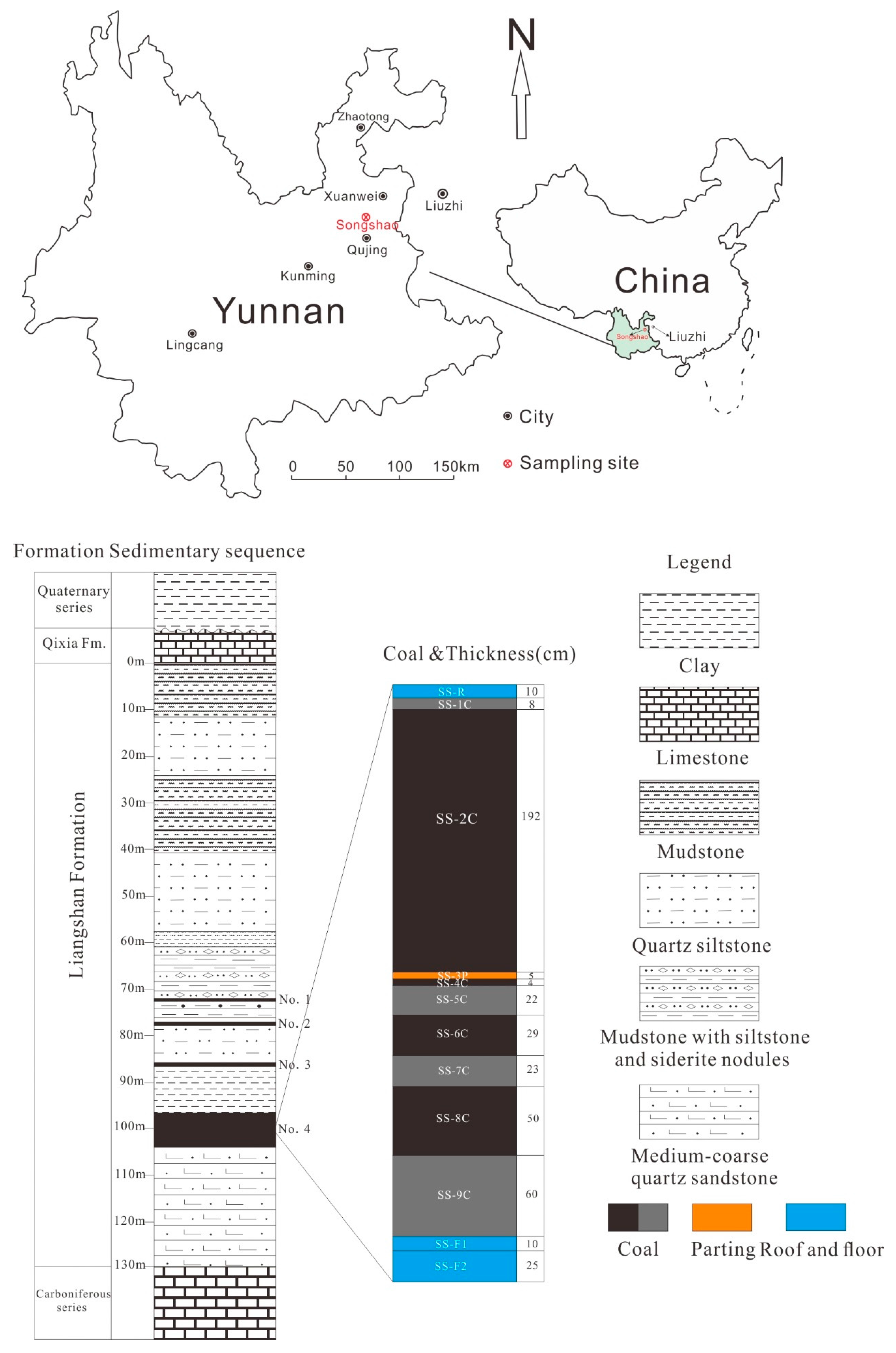
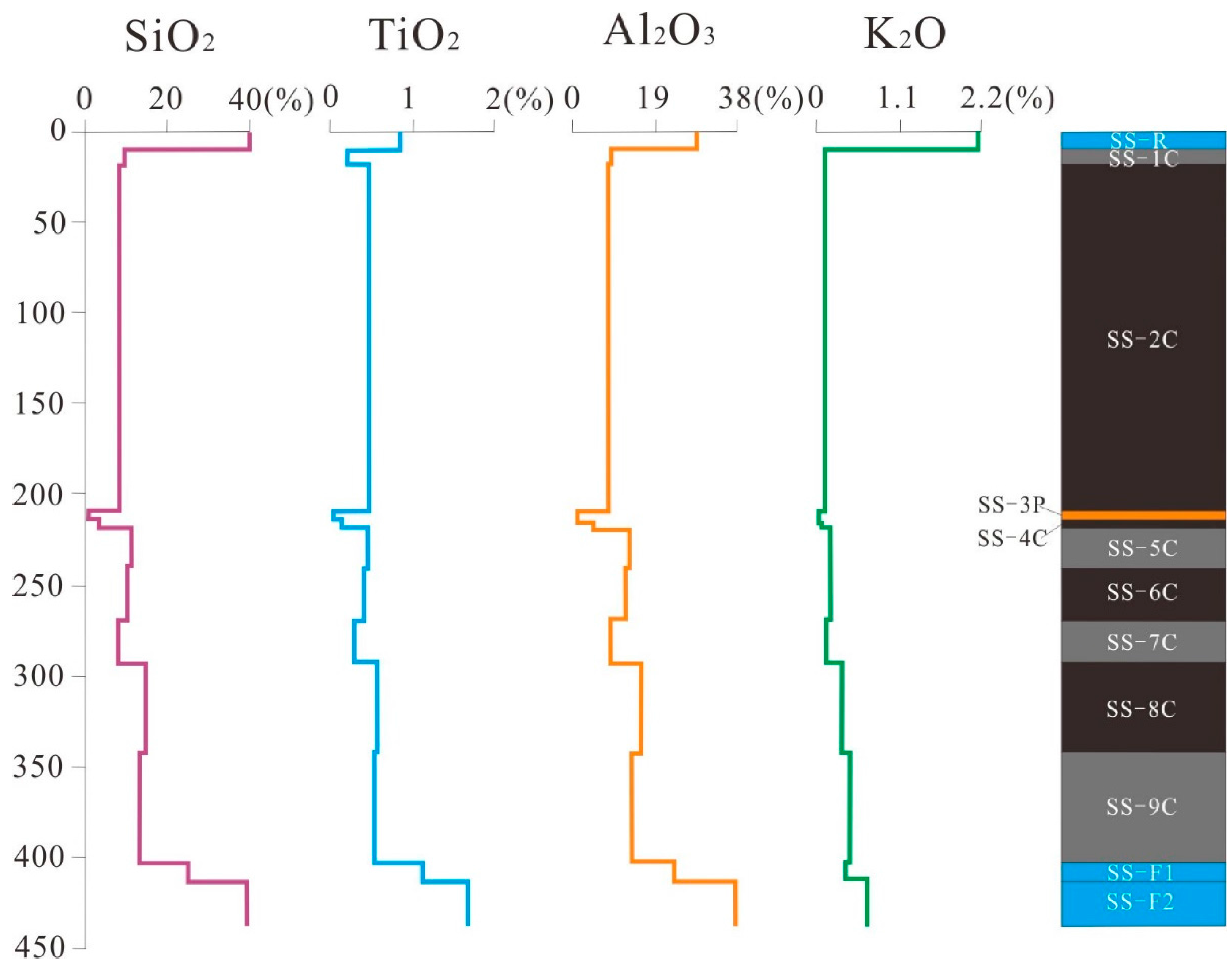
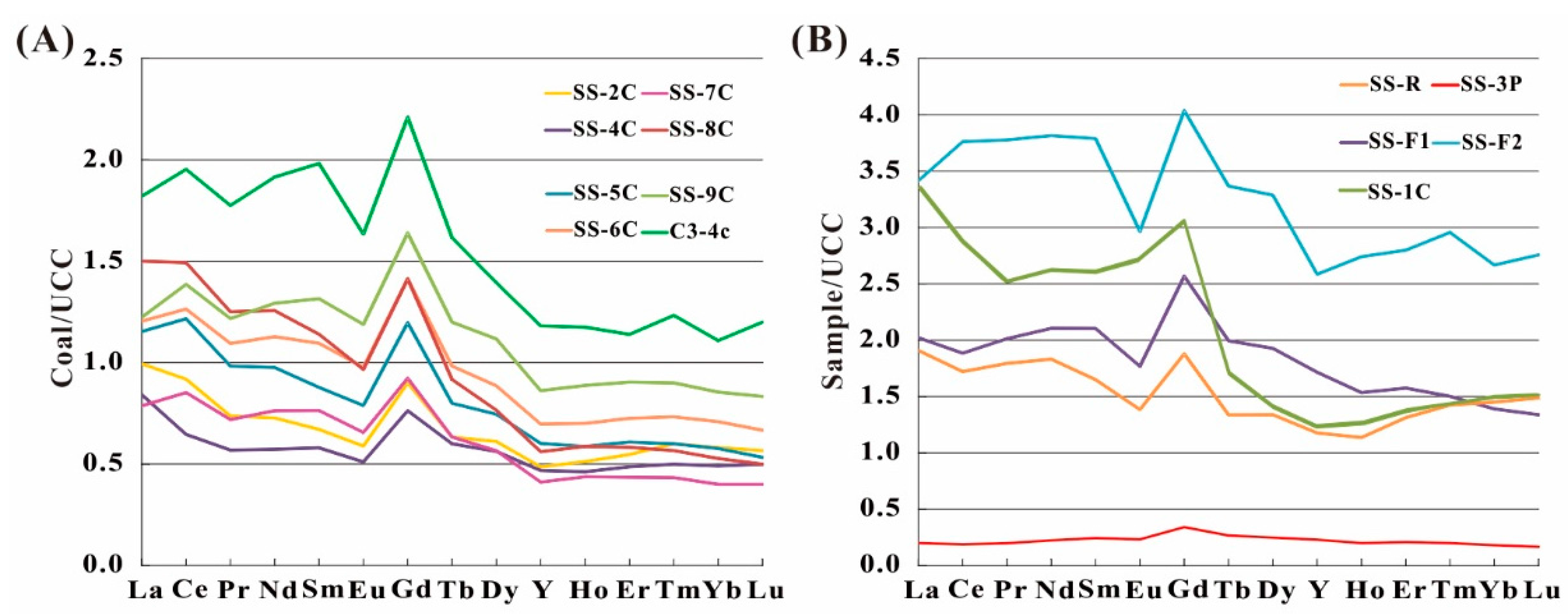
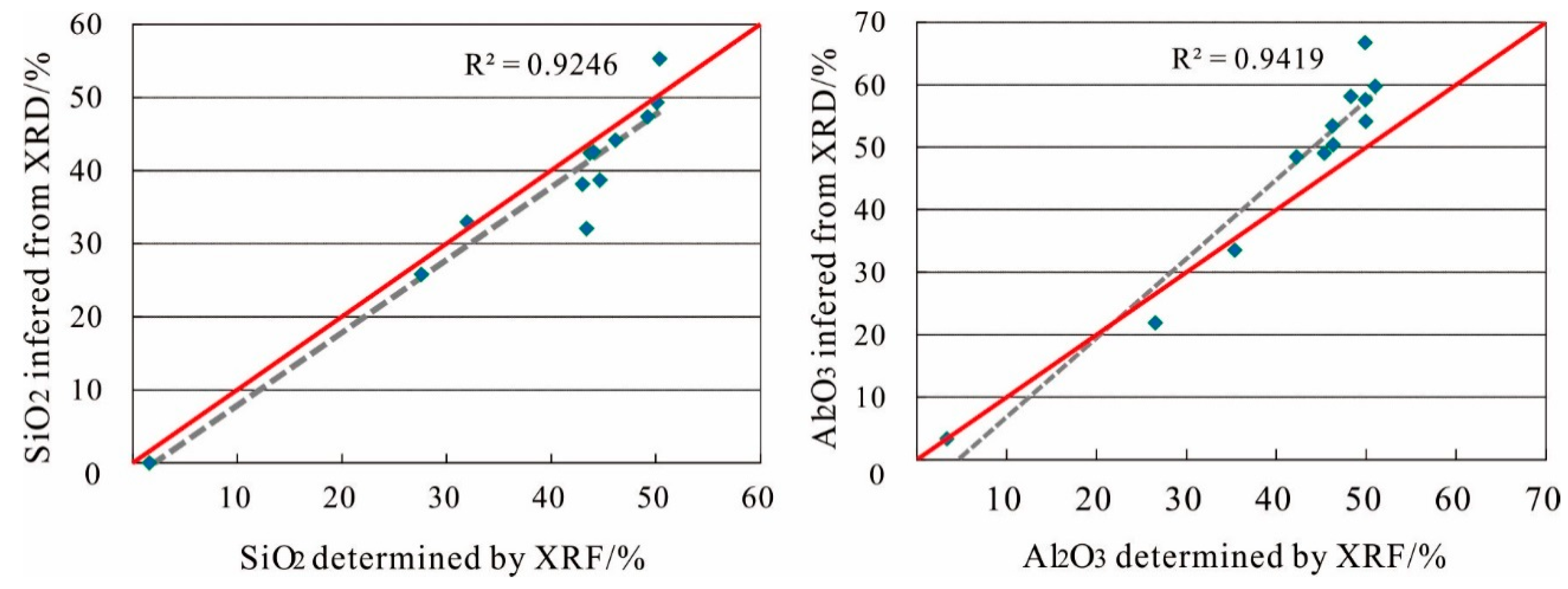
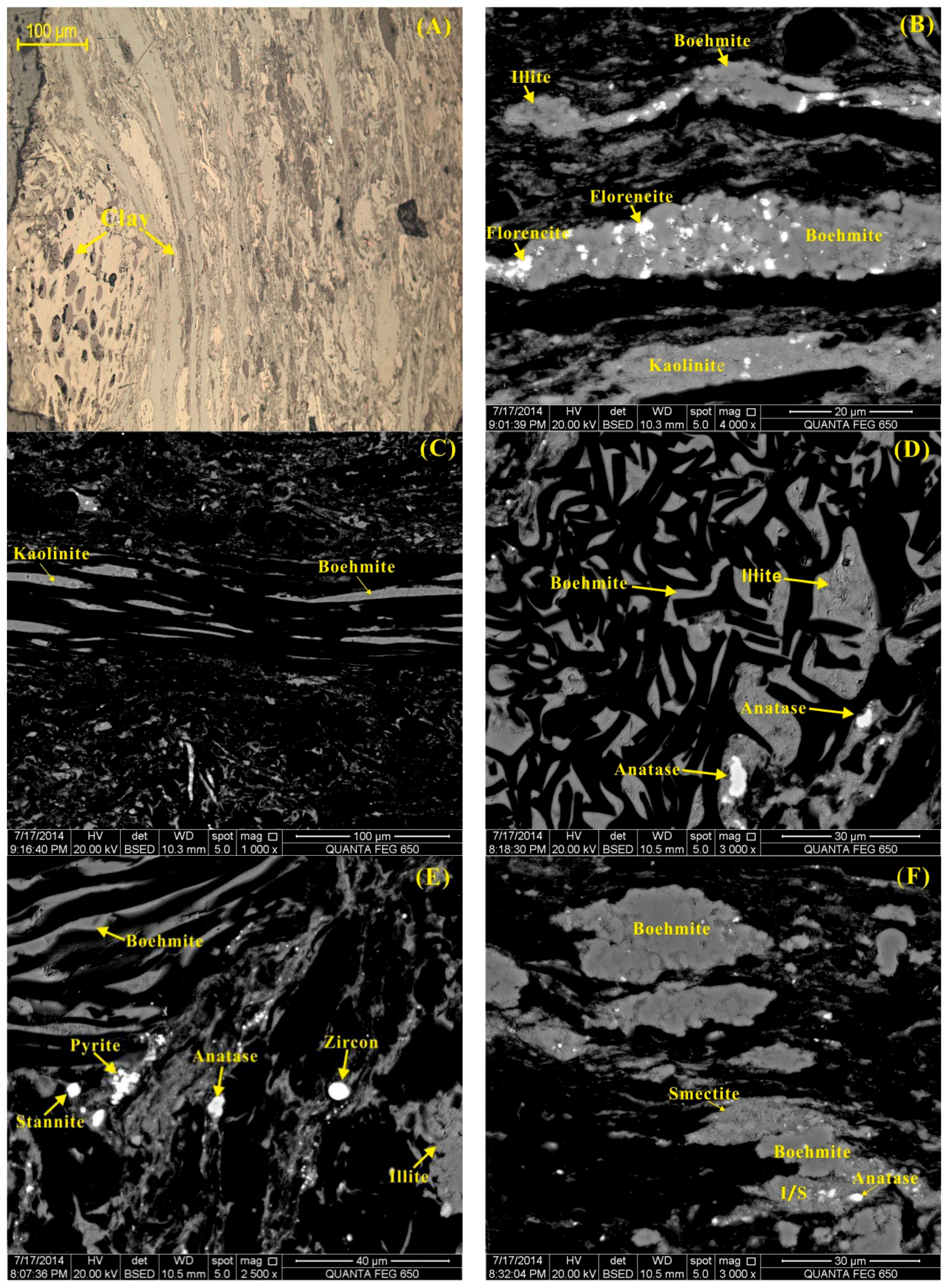
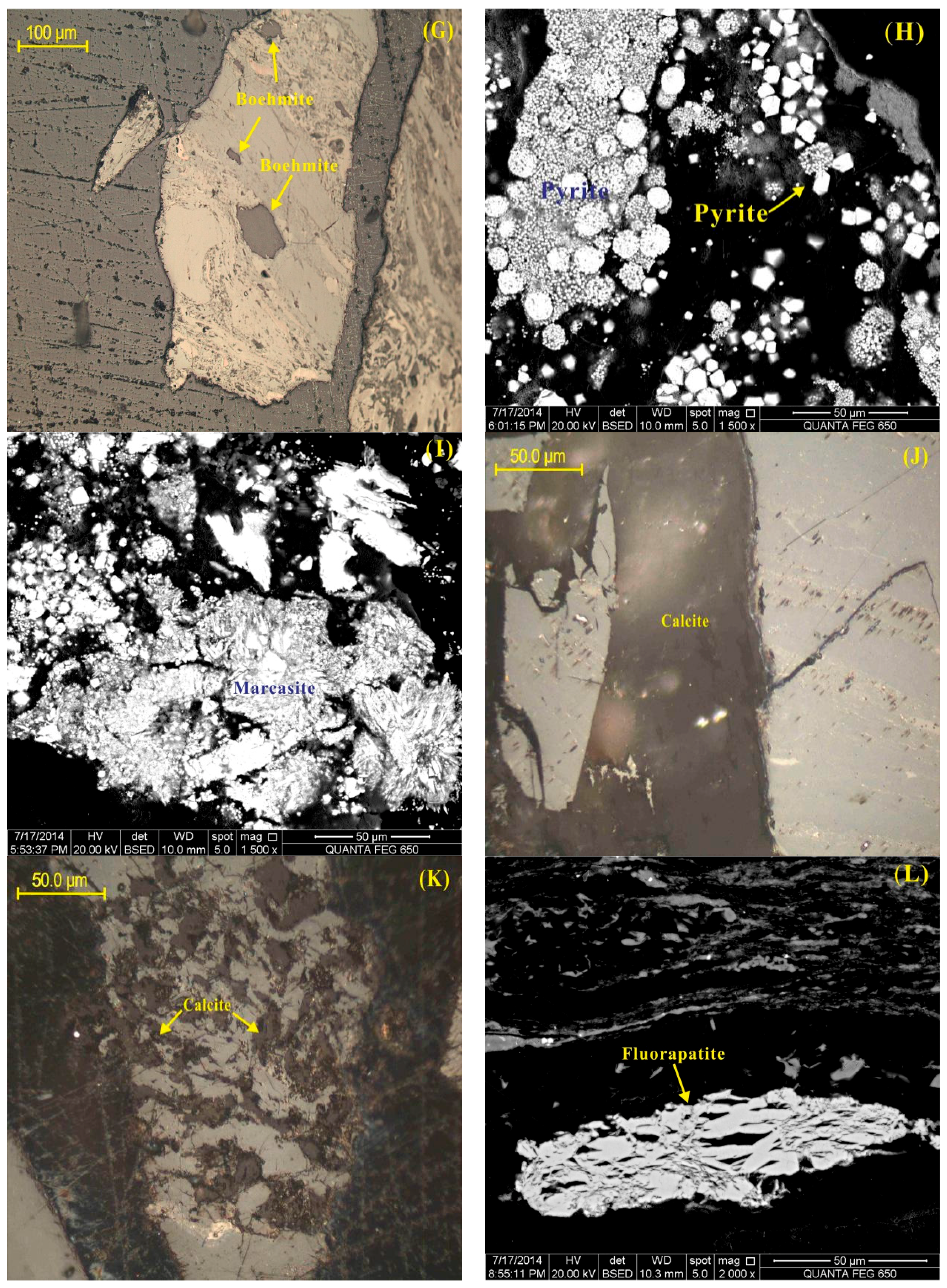
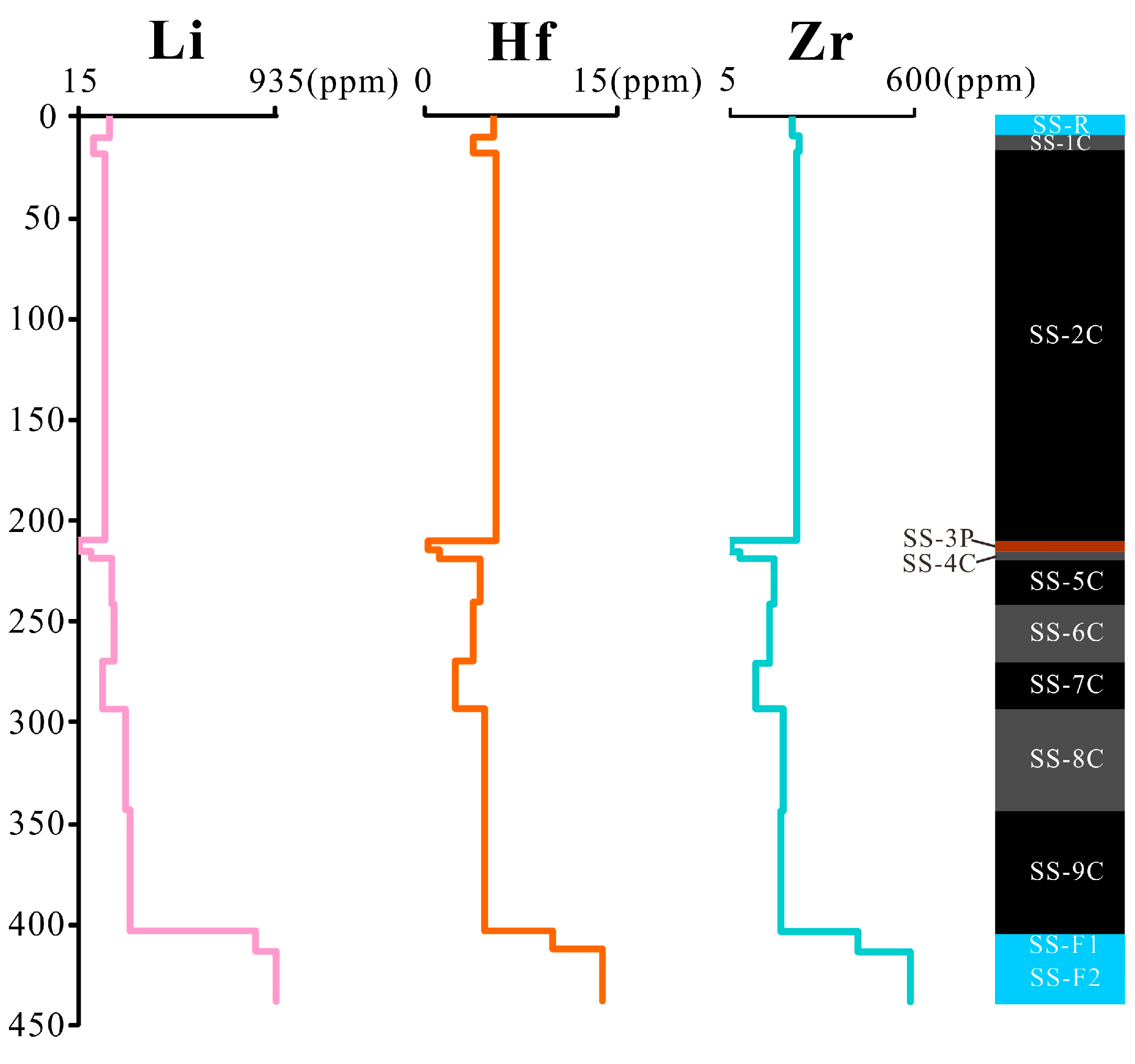
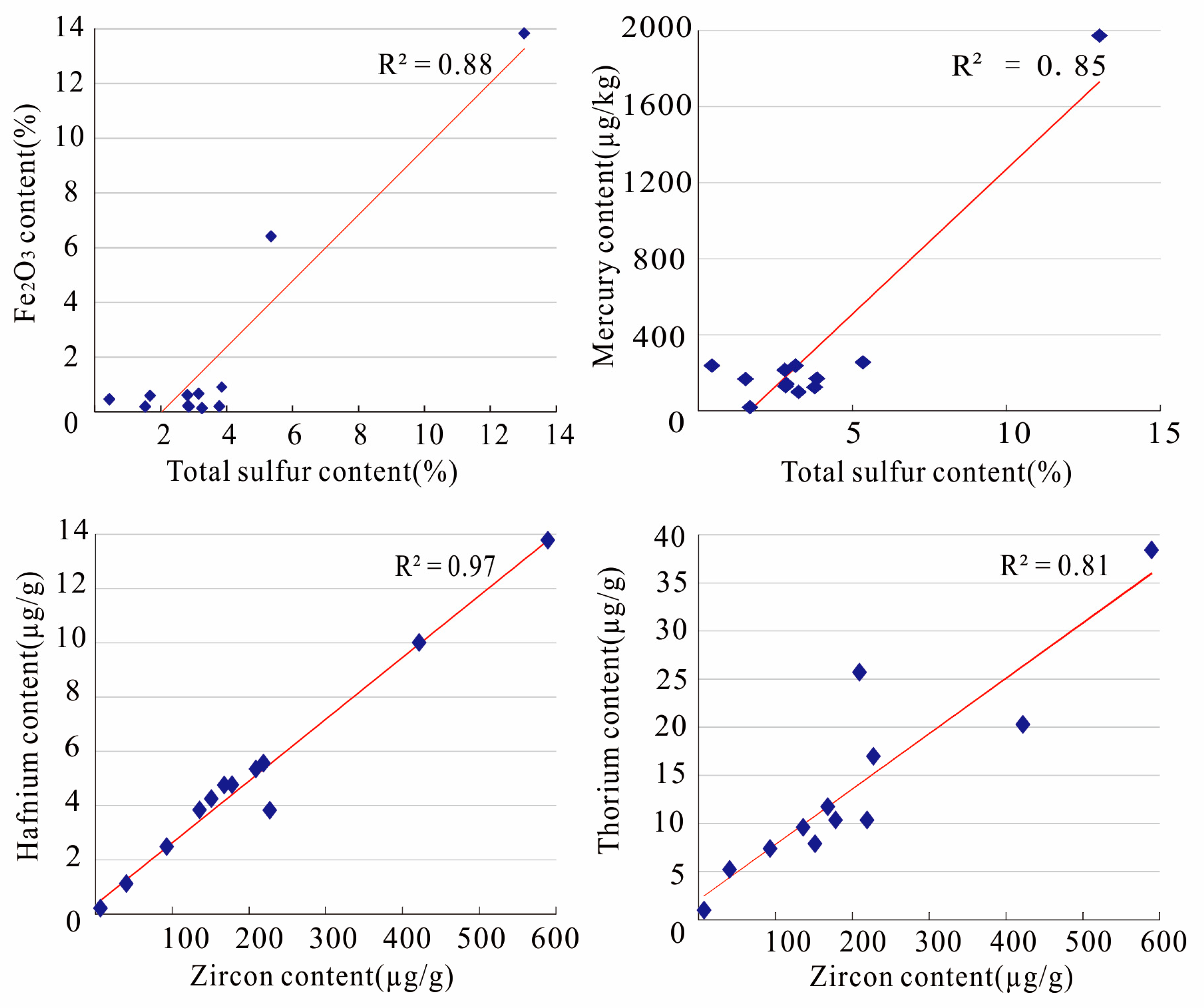
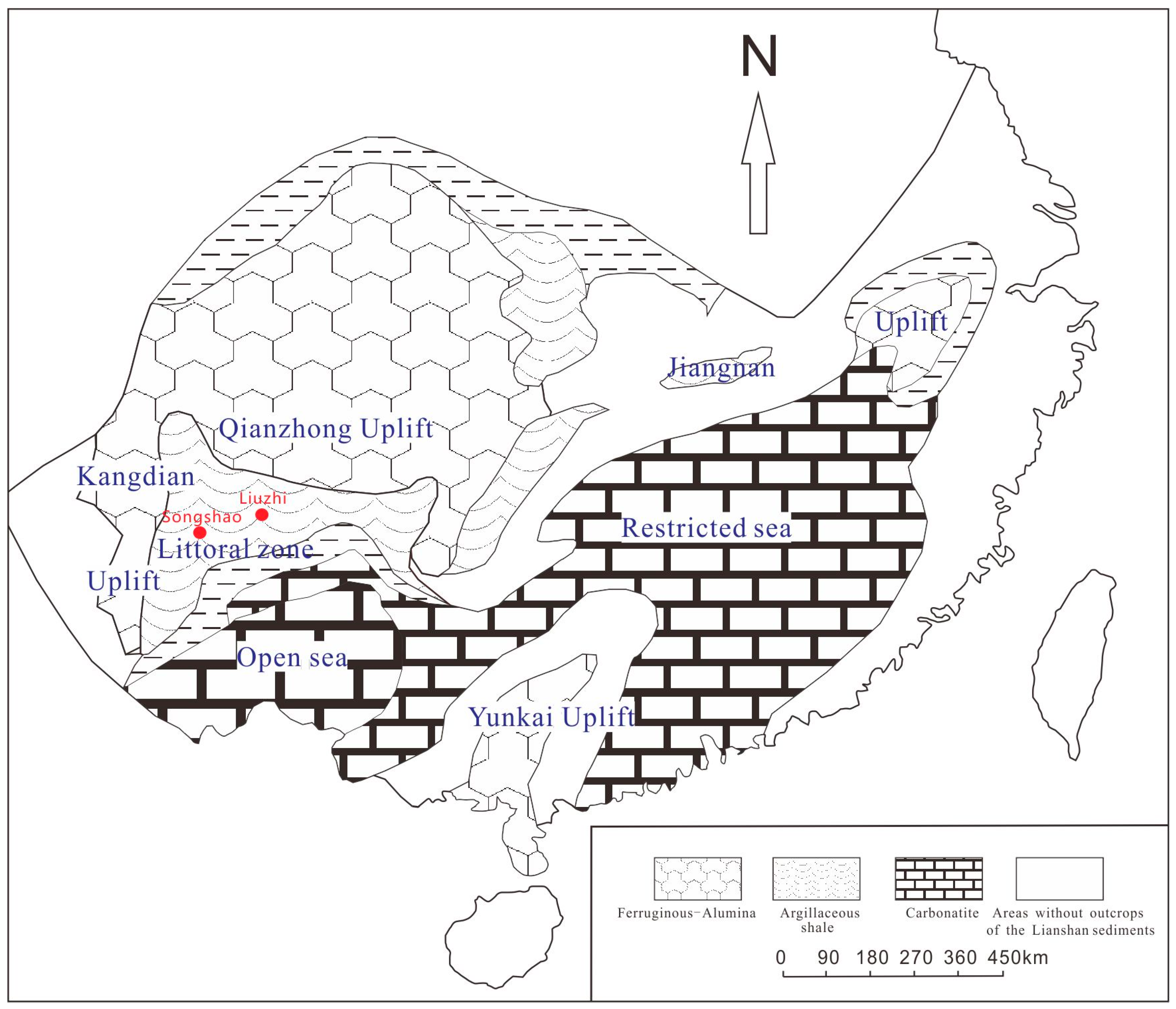
| Sample | Rr | Mad | Ad | VMdaf | St,d | Ss,d | Sp,d | So,daf | Ndaf | Cdaf | Hdaf |
|---|---|---|---|---|---|---|---|---|---|---|---|
| SS-R | nd | nd | 79.88 | nd | 5.35 | nd | nd | nd | nd | nd | nd |
| SS-1C | 1.35 | 1.40 | 33.35 | 29.84 | 13.03 | 0.31 | 8.06 | 6.99 | 0.70 | 75.50 | 4.04 |
| SS-2C | 1.21 | 0.64 | 19.22 | 30.68 | 3.85 | 0.05 | 0.71 | 3.83 | 1.10 | 85.25 | 4.84 |
| SS-3P | 1.17 | 0.47 | 47.19 | 77.10 | 1.68 | 0.20 | 0.04 | 2.72 | 0.62 | 64.71 | 3.16 |
| SS-4C | 1.26 | 0.63 | 9.67 | 27.66 | 3.78 | bdl | 0.11 | 4.09 | 1.16 | 87.57 | 4.73 |
| SS-5C | 1.29 | 0.59 | 26.35 | 28.84 | 2.86 | bdl | 0.05 | 3.84 | 1.21 | 84.75 | 4.98 |
| SS-6C | 1.23 | 0.52 | 24.20 | 29.81 | 2.83 | bdl | 0.07 | 3.68 | 1.11 | 84.97 | 4.93 |
| SS-7C | 1.41 | 0.44 | 17.84 | 28.31 | 3.26 | 0.01 | 0.10 | 3.83 | 0.98 | 86.05 | 4.82 |
| SS-8C | 1.22 | 0.58 | 32.77 | 31.62 | 2.81 | bdl | 0.47 | 3.55 | 1.11 | 83.36 | 5.18 |
| SS-9C | 1.24 | 0.52 | 29.85 | 29.87 | 3.16 | 0.07 | 0.25 | 4.04 | 1.01 | 83.63 | 4.97 |
| SS-F1 | nd | nd | 50.33 | nd | 1.53 | nd | nd | nd | nd | nd | nd |
| SS-F2 | nd | nd | 80.78 | nd | 0.45 | nd | nd | nd | nd | nd | nd |
| WA | 1.24 | 0.60 | 23.80 | 30.91 | 3.61 | 0.04 | 0.62 | 3.87 | 1.07 | 84.32 | 4.88 |
| Sample | Th (cm) | LOI | SiO2 | TiO2 | Al2O3 | Fe2O3 | MnO | MgO | CaO | Na2O | K2O | P2O5 | SiO2/Al2O3 |
|---|---|---|---|---|---|---|---|---|---|---|---|---|---|
| SS-R | 10 | 20.12 | 40.27 | 0.86 | 28.27 | 6.41 | 0.01 | 1.03 | 0.35 | 0.05 | 2.15 | 0.06 | 1.42 |
| SS-1C | 8 | 66.65 | 9.08 | 0.2 | 8.73 | 13.83 | 0.01 | 0.13 | 0.14 | 0.04 | 0.11 | 0.2 | 1.04 |
| SS-2C | 192 | 80.78 | 8.35 | 0.46 | 8.07 | 0.9 | 0 | 0.14 | 0.37 | 0.03 | 0.1 | 0.12 | 1.03 |
| SS-3P | 5 | 52.81 | 0.76 | 0.02 | 1.6 | 0.59 | 0.08 | 0.26 | 36.97 | 0.02 | 0 | 0.01 | 0.48 |
| SS-4C | 4 | 90.33 | 3.07 | 0.13 | 4.8 | 0.2 | 0 | 0.18 | 0.41 | 0.19 | 0.03 | 0.03 | 0.64 |
| SS-5C | 22 | 73.65 | 11.55 | 0.44 | 13.08 | 0.19 | 0 | 0.36 | 0.1 | 0.04 | 0.19 | 0.03 | 0.88 |
| SS-6C | 29 | 75.8 | 10.36 | 0.42 | 12.28 | 0.22 | 0 | 0.3 | 0.07 | 0.02 | 0.19 | 0.02 | 0.84 |
| SS-7C | 23 | 82.16 | 7.72 | 0.29 | 8.86 | 0.13 | 0 | 0.27 | 0.1 | 0.02 | 0.13 | 0.03 | 0.87 |
| SS-8C | 50 | 67.23 | 14.57 | 0.57 | 15.75 | 0.61 | 0 | 0.4 | 0.11 | 0.03 | 0.33 | 0.06 | 0.93 |
| SS-9C | 60 | 70.15 | 13.72 | 0.54 | 13.74 | 0.66 | 0 | 0.31 | 0.08 | 0.02 | 0.42 | 0.03 | 1 |
| SS-F1 | 10 | 49.67 | 25.24 | 1.12 | 22.83 | 0.19 | 0 | 0.21 | 0.07 | 0.01 | 0.39 | 0.03 | 1.11 |
| SS-F2 | 25 | 19.22 | 39.79 | 1.65 | 37.45 | 0.46 | 0 | 0.31 | 0.05 | 0.01 | 0.64 | 0.06 | 1.06 |
| SS Coal | - | 76.5 | 10.24 | 0.46 | 10.56 | 0.95 | 0 | 0.23 | 0.23 | 0.03 | 0.19 | 0.08 | 0.97 |
| Chinese Coal a | n.d. | n.d. | 8.47 | 0.33 | 5.98 | 4.85 | 0.02 | 0.22 | 1.23 | 0.16 | 0.19 | 0.09 | 1.42 |
| CC | n.d. | n.d. | 1.21 | 1.4 | 1.77 | 0.2 | 0.15 | 1.06 | 0.19 | 0.18 | 1.01 | 0.88 | 0.68 |
| Sample | SS-R | SS-1C | SS-2C | SS-3P | SS-4C | SS-5C | SS-6C | SS-7C | SS-8C | SS-9C | SS-F1 | SS-F2 | World | SC | C1 | UCC | PC | C2 |
|---|---|---|---|---|---|---|---|---|---|---|---|---|---|---|---|---|---|---|
| Li | 160.70 | 84.29 | 140.24 | 17.10 | 72.32 | 170.02 | 184.16 | 124.26 | 231.48 | 257.89 | 844.97 | 944.01 | 14.00 | 170.39 | 12.17 | 20.00 | 116.01 | 5.80 |
| Be | 3.45 | 3.29 | 0.98 | 0.37 | 0.78 | 1.88 | 1.87 | 1.30 | 1.89 | 1.92 | 3.24 | 3.19 | 2.00 | 1.41 | 0.71 | 3.00 | 1.62 | 0.54 |
| F | 670.30 | 138.20 | 131.09 | 49.00 | 154.90 | 176.81 | 175.67 | 158.68 | 204.91 | 174.03 | 165.51 | 293.06 | 82.00 | 153.84 | 1.88 | - | 348.55 | - |
| Sc | 25.53 | 25.02 | 3.81 | 1.61 | 7.10 | 5.07 | 6.41 | 4.13 | 4.06 | 6.87 | 10.47 | 30.63 | 3.70 | 5.03 | 1.36 | 11.00 | 4.57 | 0.42 |
| V | 231.22 | 383.34 | 57.25 | 9.74 | 34.93 | 76.15 | 72.88 | 55.08 | 88.81 | 99.12 | 231.22 | 120.60 | 28.00 | 75.55 | 2.70 | 60.00 | 59.02 | 0.98 |
| Cr | 149.02 | 87.56 | 35.44 | 6.44 | 19.58 | 41.68 | 36.16 | 34.45 | 43.83 | 54.30 | 149.02 | 111.25 | 17.00 | 40.26 | 2.37 | 35.00 | 32.18 | 0.92 |
| Co | 20.24 | 19.44 | 5.76 | 6.38 | 3.70 | 3.28 | 2.23 | 4.35 | 2.78 | 2.92 | 20.24 | 2.46 | 6.00 | 4.73 | 0.79 | 10.00 | 5.17 | 0.52 |
| Ni | 55.07 | 34.39 | 14.59 | 11.27 | 6.26 | 20.50 | 14.34 | 15.10 | 23.40 | 27.39 | 55.07 | 38.61 | 17.00 | 18.28 | 1.08 | 20.00 | 17.84 | 0.89 |
| Cu | 60.63 | 20.57 | 23.98 | 3.82 | 23.53 | 34.69 | 32.71 | 34.61 | 47.51 | 32.42 | 60.63 | 17.88 | 16.00 | 29.80 | 1.86 | 25.00 | 25.00 | 1.00 |
| Zn | 150.53 | 9.04 | 2.42 | 11.40 | 0.60 | 2.88 | 2.93 | 3.77 | 9.96 | 7.09 | 150.53 | 8.69 | 28.00 | 4.46 | 0.16 | 71.00 | 12.65 | 0.18 |
| Ga | 50.30 | 15.91 | 7.43 | 1.10 | 3.98 | 10.80 | 9.00 | 10.02 | 11.37 | 14.08 | 36.39 | 24.71 | 6.00 | 9.46 | 1.58 | 17.00 | 8.26 | 0.49 |
| Ge | 1.46 | 0.84 | 1.64 | 0.15 | 0.24 | 0.65 | 0.88 | 1.32 | 1.11 | 0.98 | 0.86 | 1.28 | 2.40 | 1.29 | 0.54 | 1.60 | 1.68 | 1.05 |
| As | 9.34 | 12.31 | 2.87 | 1.06 | 2.11 | 1.53 | 1.40 | 1.51 | 2.79 | 4.02 | 2.18 | 2.25 | 9.00 | 2.96 | 0.33 | 2.00 | 3.81 | 1.91 |
| Se | 7.22 | 9.17 | 4.16 | 0.94 | 4.60 | 5.53 | 6.18 | 4.08 | 7.01 | 6.22 | 3.90 | 2.61 | 1.60 | 5.18 | 3.24 | 0.08 | 3.92 | 47.23 |
| Rb | 96.10 | 3.71 | 1.97 | 0.09 | 0.55 | 2.77 | 2.71 | 1.97 | 4.43 | 4.02 | 2.94 | 4.34 | 18.00 | 2.69 | 0.15 | 112.00 | 8.02 | 0.07 |
| Sr | 104.84 | 588.93 | 493.21 | 180.81 | 139.62 | 22.06 | 22.96 | 16.11 | 31.17 | 17.25 | 19.01 | 10.42 | 100.00 | 267.14 | 2.67 | 350.00 | 209.03 | 0.60 |
| Zr | 209.44 | 227.44 | 219.24 | 7.06 | 40.47 | 151.48 | 136.14 | 93.08 | 178.18 | 168.14 | 422.17 | 589.72 | 36.00 | 184.55 | 5.13 | 190.00 | 132.90 | 0.70 |
| Nb | 18.43 | 4.15 | 8.89 | 0.94 | 2.56 | 8.21 | 8.15 | 5.82 | 8.51 | 7.56 | 21.85 | 32.61 | 4.00 | 8.10 | 2.03 | 25.00 | 6.68 | 0.27 |
| Mo | 0.69 | 2.08 | 0.39 | 0.14 | 0.22 | 1.77 | 0.50 | 0.57 | 0.80 | 0.73 | 0.88 | 1.23 | 2.10 | 0.62 | 0.29 | 1.50 | 1.13 | 0.76 |
| Ag | 0.97 | 1.29 | 1.18 | bdl | 0.17 | 0.83 | 0.76 | 0.44 | 0.96 | 0.97 | 0.97 | 2.54 | bdl | 1.00 | bdl | 0.05 | 0.65 | 13.07 |
| Cd | 0.53 | 0.56 | 0.29 | 0.05 | 0.19 | 0.30 | 0.28 | 0.23 | 0.63 | 0.50 | 0.53 | 0.67 | 0.20 | 0.36 | 1.81 | 0.10 | 0.31 | 3.05 |
| In | 0.19 | 0.10 | 0.04 | 0.13 | 0.02 | 0.05 | 0.04 | 0.05 | 0.06 | 0.09 | 0.25 | 0.13 | 0.04 | 0.05 | 1.30 | - | 0.05 | - |
| Sn | 4.97 | 5.12 | 2.54 | 38.34 | 0.68 | 2.02 | 1.51 | 2.50 | 2.16 | 6.26 | 8.68 | 5.73 | 1.40 | 3.45 | 2.46 | 5.50 | 2.73 | 0.50 |
| Sb | 0.97 | 0.62 | 0.26 | 0.12 | 0.23 | 0.37 | 0.30 | 0.18 | 0.46 | 0.51 | 0.47 | 0.66 | 1.00 | 0.33 | 0.33 | 0.20 | 0.57 | 2.83 |
| Cs | 15.02 | 0.69 | 0.36 | 0.14 | 0.12 | 1.51 | 1.14 | 0.77 | 2.08 | 2.72 | 3.13 | 3.44 | 1.10 | 1.09 | 0.99 | 3.70 | 1.09 | 0.29 |
| Ba | 131.56 | 77.11 | 24.02 | 6.63 | 5.59 | 10.54 | 7.81 | 6.70 | 15.72 | 16.17 | 10.38 | 5.04 | 150.00 | 19.47 | 0.13 | 550.00 | 64.86 | 0.12 |
| La | 100.65 | 29.82 | 5.99 | 25.27 | 34.61 | 36.14 | 23.61 | 45.01 | 36.70 | 60.67 | 102.44 | 57.28 | 11.00 | 34.27 | 3.12 | 30.00 | 83.12 | 2.77 |
| Ce | 185.72 | 58.81 | 12.06 | 41.35 | 77.86 | 80.91 | 54.56 | 95.52 | 88.70 | 120.63 | 240.78 | 110.15 | 23.00 | 72.30 | 3.14 | 64.00 | 185.05 | 2.89 |
| Pr | 18.18 | 5.23 | 1.41 | 4.04 | 6.98 | 7.77 | 5.11 | 8.88 | 8.64 | 14.30 | 17.93 | 12.74 | 3.40 | 6.70 | 1.97 | 7.10 | 15.97 | 2.25 |
| Nd | 68.89 | 18.92 | 5.82 | 14.89 | 25.38 | 29.32 | 19.84 | 32.67 | 33.62 | 54.74 | 68.81 | 47.63 | 12.00 | 24.91 | 2.08 | 26.00 | 60.98 | 2.35 |
| Sm | 11.82 | 3.02 | 1.10 | 2.61 | 3.95 | 4.93 | 3.44 | 5.13 | 5.92 | 9.47 | 11.40 | 7.43 | 2.20 | 4.10 | 1.86 | 4.50 | 10.09 | 2.24 |
| Eu | 2.44 | 0.53 | 0.21 | 0.46 | 0.71 | 0.88 | 0.59 | 0.87 | 1.07 | 1.59 | 1.73 | 1.25 | 0.43 | 0.73 | 1.70 | 0.90 | 1.59 | 1.77 |
| Gd | 11.63 | 3.42 | 1.30 | 2.90 | 4.55 | 5.37 | 3.51 | 5.37 | 6.23 | 9.76 | 10.35 | 7.14 | 2.70 | 4.44 | 1.65 | 3.80 | 9.50 | 2.50 |
| Tb | 1.10 | 0.38 | 0.16 | 0.36 | 0.48 | 0.59 | 0.38 | 0.55 | 0.72 | 1.20 | 1.26 | 0.80 | 0.31 | 0.49 | 1.57 | 0.60 | 1.14 | 1.90 |
| Dy | 5.30 | 2.14 | 0.87 | 1.97 | 2.61 | 3.10 | 1.98 | 2.68 | 3.91 | 6.74 | 6.77 | 4.69 | 2.10 | 2.61 | 1.24 | 3.50 | 6.30 | 1.80 |
| Y | 25.96 | 10.69 | 5.05 | 10.31 | 13.23 | 15.34 | 9.04 | 12.34 | 18.96 | 37.75 | 56.89 | 25.90 | 8.40 | 12.79 | 1.52 | 22.00 | 45.75 | 2.08 |
| Ho | 1.02 | 0.41 | 0.16 | 0.37 | 0.47 | 0.56 | 0.35 | 0.47 | 0.71 | 1.23 | 1.19 | 0.91 | 0.57 | 0.48 | 0.85 | 0.80 | 1.14 | 1.42 |
| Er | 3.20 | 1.26 | 0.48 | 1.12 | 1.40 | 1.67 | 1.00 | 1.34 | 2.08 | 3.62 | 3.49 | 3.02 | 1.00 | 1.45 | 1.45 | 2.30 | 3.42 | 1.49 |
| Tm | 0.44 | 0.18 | 0.06 | 0.15 | 0.18 | 0.22 | 0.13 | 0.17 | 0.27 | 0.45 | 0.44 | 0.43 | 0.30 | 0.20 | 0.65 | 0.30 | 0.44 | 1.46 |
| Yb | 3.26 | 1.28 | 0.40 | 1.08 | 1.27 | 1.56 | 0.88 | 1.16 | 1.88 | 3.06 | 2.96 | 3.19 | 1.00 | 1.38 | 1.38 | 2.20 | 3.03 | 1.38 |
| Lu | 0.46 | 0.17 | 0.05 | 0.15 | 0.16 | 0.20 | 0.12 | 0.15 | 0.25 | 0.40 | 0.39 | 0.45 | 0.20 | 0.18 | 0.91 | 0.30 | 0.40 | 1.34 |
| Hf | 5.34 | 3.83 | 5.56 | 0.21 | 1.12 | 4.25 | 3.83 | 2.48 | 4.76 | 4.75 | 10.00 | 13.78 | 1.20 | 4.81 | 4.01 | 5.80 | 3.55 | 0.61 |
| Ta | 1.28 | 0.36 | 0.70 | 0.29 | 0.17 | 0.59 | 0.59 | 0.38 | 0.42 | 0.27 | 1.41 | 2.15 | 0.30 | 0.55 | 1.83 | 2.20 | 0.46 | 0.21 |
| W | 5.17 | 0.24 | 1.20 | 0.14 | 0.16 | 0.56 | 0.50 | 0.62 | 0.58 | 0.66 | 2.65 | 11.90 | 0.99 | 0.87 | 0.88 | 2.00 | 0.91 | 0.46 |
| Hg | 0.26 | 1.97 | 0.17 | 0.02 | 0.12 | 0.14 | 0.13 | 0.10 | 0.21 | 0.24 | 0.17 | 0.24 | 0.10 | 0.21 | 2.11 | 0.02 | 0.17 | 8.63 |
| Tl | 0.79 | 3.45 | bdl | bdl | bdl | bdl | bdl | bdl | 0.02 | 0.03 | 0.79 | 0.02 | 0.58 | 0.07 | 0.12 | 0.80 | 0.25 | 0.31 |
| Pb | 34.89 | 11.87 | 10.11 | 0.97 | 6.79 | 15.73 | 17.38 | 9.81 | 18.75 | 21.37 | 34.89 | 7.12 | 9.00 | 13.65 | 1.52 | 20.00 | 12.03 | 0.60 |
| Bi | 1.80 | 0.04 | 0.21 | 0.60 | bdl | 0.23 | 0.19 | bdl | 0.13 | 1.06 | 1.03 | 1.84 | 1.10 | 0.32 | 0.29 | - | 0.59 | - |
| Th | 25.72 | 16.97 | 10.34 | 0.99 | 5.22 | 7.90 | 9.60 | 7.37 | 10.36 | 11.75 | 20.28 | 38.40 | 3.20 | 10.16 | 3.17 | 10.70 | 7.74 | 0.72 |
| U | 5.62 | 3.91 | 2.25 | 0.48 | 1.18 | 3.70 | 3.24 | 2.92 | 3.96 | 4.09 | 8.27 | 8.69 | 1.90 | 2.94 | 1.55 | 2.00 | 2.58 | 1.29 |
| Sample | LTA | Kaolinite | Illite | I/S | Marcasite | Pyrite | Calcite | Anatase | Boehmite | Diaspore | Brucite |
|---|---|---|---|---|---|---|---|---|---|---|---|
| SS-R | - | 54.5 | 39.2 | - | - | 5.1 | - | 1.2 | - | - | - |
| SS-1C | 47.2 | 41.3 | - | - | 12.7 | 44.6 | - | 0.9 | - | - | - |
| SS-2C | 22.9 | 55.2 | 17.9 | - | - | - | 6.1 | 1.3 | 3.4 | 14.9 | 1.1 |
| SS-3P | 73.8 | - | - | - | - | - | 97.7 | - | 2.1 | 0.1 | 0 |
| SS-4C | 11.0 | 22.6 | 17.3 | 14.7 | - | - | 4.7 | 1.7 | 34.3 | 4.3 | 0.4 |
| SS-5C | 31.9 | 50.8 | 9.1 | 14.6 | - | - | - | 0.6 | 24.9 | - | - |
| SS-6C | 23.7 | 60.5 | 6.7 | 1.7 | - | - | - | 0.9 | 30.3 | - | - |
| SS-7C | 20.7 | 51.8 | 6.1 | - | - | - | - | 0.1 | 34.2 | 7.6 | 0.3 |
| SS-8C | 39.0 | 53.7 | 14.8 | - | - | - | - | 0.4 | 25.3 | 5.1 | 0.7 |
| SS-9C | 35.1 | 63.6 | 14.7 | - | - | - | - | - | 20.9 | - | 0.4 |
| SS-F1 | - | 83.6 | 6.3 | - | - | - | - | 0.7 | 9.4 | - | - |
| SS-F2 | - | 78.5 | 7.7 | - | - | - | - | 1.0 | 12.9 | - | - |
© 2016 by the author; licensee MDPI, Basel, Switzerland. This article is an open access article distributed under the terms and conditions of the Creative Commons Attribution (CC-BY) license (http://creativecommons.org/licenses/by/4.0/).
Share and Cite
Wang, R. Geological Controls on Mineralogy and Geochemistry of an Early Permian Coal from the Songshao Mine, Yunnan Province, Southwestern China. Minerals 2016, 6, 66. https://doi.org/10.3390/min6030066
Wang R. Geological Controls on Mineralogy and Geochemistry of an Early Permian Coal from the Songshao Mine, Yunnan Province, Southwestern China. Minerals. 2016; 6(3):66. https://doi.org/10.3390/min6030066
Chicago/Turabian StyleWang, Ruixue. 2016. "Geological Controls on Mineralogy and Geochemistry of an Early Permian Coal from the Songshao Mine, Yunnan Province, Southwestern China" Minerals 6, no. 3: 66. https://doi.org/10.3390/min6030066
APA StyleWang, R. (2016). Geological Controls on Mineralogy and Geochemistry of an Early Permian Coal from the Songshao Mine, Yunnan Province, Southwestern China. Minerals, 6(3), 66. https://doi.org/10.3390/min6030066







